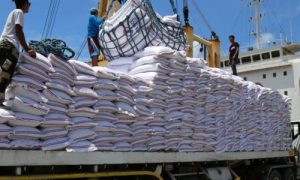Indonesia’s Massive Sugar-Bioethanol Project In South Papua Causes Locals To Fear Exploitation – Analysis

Indonesia’s plan to convert vast acres in Papua into a sugarcane plantation for self-sufficiency faces opposition from indigenous communities and environmentalists. Previous failed projects, like the Merauke Integrated Food and Energy Estate, fuel skepticism. President-elect Prabowo Subianto aims to continue self-sufficiency efforts, emphasizing bioethanol as an alternative to coal. However, locals fear land grabs and ecological damage. Critics highlight past projects’ environmental impact and lack of community consultation. Calls to scrap the sugarcane project persist amidst concerns over deforestation and indigenous rights.
Indonesia is going ahead with a project to convert millions of acres in Papua into a gigantic sugarcane plantation so the restive region can become self-sufficient in sugar and its related liquid fuel, bioethanol.
But indigenous communities and environmentalists worry that the project in South Papua’s Merauke regency will lead to land grabs, ecological damage, and the destruction of traditional livelihoods.
They have been scarred by previous failed ventures in this sprawling regency, notably the Merauke Integrated Food and Energy Estate (MIFEE), which they say cheated them on payments, broke promises, and disregarded local perspectives.
Investment Minister Bahlil Lahadalia has been touting the importance of involving local communities in investment plans, even as he has acknowledged the failures of previous projects in Papua.
He insisted this time would be different.
“This program in Merauke has failed several times, right? There was MIFEE,” Bahlil told journalists during a visit to the project site last month.
“I don’t want this one to suffer the same fate.”
He said one reason similar projects had failed before was the seeds used.
“We have learned from the mistakes of the past,” he said.
“This time, we are addressing potential issues like seedling quality from the outset.”
Faced with Indonesia’s rising consumption of sugar and its consequent increase in imports, President Joko “Jokowi” Widodo announced a plan in 2020 for the country to become self-sufficient in the commodity in a decade.
A key to achieving this and avoiding the pitfalls of previous attempts, he said then, was to expand cane area under state-run sugar mills beyond the traditional Java heartland to other regions and islands, the International Sugar Association said on its website.
During his election campaign three years later, Defense Minister Prabowo Subianto – now the president-elect – promised to reduce Indonesia’s reliance on coal, the dirtiest fossil fuel. The key to achieving that goal, he had said, was to replace it with biofuels – fuel made from animal or plant waste, such as bioethanol.
Prabowo has stated time and again that he plans to continue Jokowi’s policies. The president tacitly supported Prabowo, and Prabowo’s running mate was Jokowi’s eldest son. But analysts have said the president-elect will also want to be seen as his own man with some unique policies of his own.
The new Merauke project, which will integrate the sugarcane, sugar, bioethanol and biomass power generation industries in Merauke regency, is taking off ahead of Prabowo’s induction into office and Jokowi’s exit in October.
To accelerate its implementation, Jokowi in April signed a presidential decree to form a task force assigned with enabling investments from those various industries.
Such a group’s formation was part of a requirement set out in a presidential decree signed in December 2023 on the “Acceleration of National Sugar Self-Sufficiency and the Provision of Bioethanol as Biofuel.”
Bahlil heads the task force.
Under the task force’s plan, the integrated sugar-bioethanol-biomass power generation “clusters” will be spread across some two million hectares (4,942,107 acres) in Merauke regency.
The project is divided into four clusters, with the third one, covering an area of about 504,373 hectares, set apart for the private sector. The task force hopes this cluster attracts a total investment of U.S. $5.62 billion, according to a Ministry of Investment statement issued on May 2.
Bahlil said this would be a large outlay so investors must have real credibility and must fulfill the customary rights of people in the area, the statement added.
“The factory will operate on a large scale, and in the future, this investment will actively engage local communities. We won’t allow investors to thrive while the community suffers. Absolutely not!” he said.
“Our vision is fairness. We want investors, the country, the region, and the people to all benefit together. It’s about growing together.”
But for many Papuans, these promises ring hollow. The region, rich in natural resources but plagued by poverty and a simmering armed separatist movement, has long been wary of Jakarta’s development schemes.
Papua has grappled with underdevelopment for decades. The region in Indonesia’s far east faces challenges related to infrastructure, education, healthcare, and economic opportunities. Indigenous communities have historically borne the brunt of these disparities.
The Indonesian government said it aimed to prioritize a welfare-focused approach in its efforts to spur development in Papua.
Suharso Monoarfa, chief of the National Development Planning Agency (Bappenas), said development projects should directly benefit Papuans.
“Earlier, we discussed plans to accelerate development in Papua. We will implement a welfare approach there,” the state-run Antara news agency quoted him as saying in May.
Indigenous clans get ‘token’ payment
Locals cite the example of the earlier MIFEE project that started in 2010 and which the government had said would revolutionize Indonesia’s food security. But all it did was leave a legacy of environmental damage and unfulfilled potential.
The administration of then-President Susilo Bambang Yudhoyono government had envisioned that if the MIFEE project succeeded, Indonesia would by 2030 have additional food reserves of 1.95 million tons of rice, 2.02 million tons of corn, 167,000 tons of soybeans, 64,000 head of cattle, 2.5 million tons of sugar, and 937,000 tons of palm oil per year.
The project had been expected to boost Papua’s per-capita gross domestic product to 124.2 million rupiah per year ($7,616) by 2030 and save the country 4.7 trillion rupiah ($288.2 million) in foreign exchange through reduced food imports.
Even worse, critics say, was the project’s disregard for the cultural rights and customary land ownership of indigenous communities. Customary land belongs collectively to clans.
Petrus Kaize, a representative of one of the seven clans that claims customary ownership of the land, said there had not been a formal deal with the company developing the properties for the MIFEE project.
“There has never been a written agreement regarding this land issue,” Kaize told BenarNews.
In 2012, the contractor in charge of the MIFEE project gave the clans a “token” payment of 2 billion rupiah (roughly U.S. $133,000), but no formal contract was signed, Kaize said.
Back then, the two sides had also disagreed on the length of the lease for the MIFEE project, with the government pushing for 35 years and the clans wanting 25.
‘Fish drunk on pollution’
Environmentally, greenhouse gas emissions spiked as large swaths of forest land were converted to plantations.
In Zanegi, a village in Merauke, locals told a U.K. NGO in 2013 that malnutrition problems began after a company, which had arrived to run an industrial tree plantation, began operations.
“We would eat sago and walk the forest all day without being weary. Now, the sago dies and the earth is dry,” said Yosefa, a Malind woman, who was 31 years old back then, told the Forest Peoples Program.
“The rivers are dark and oily, and the fish drunk on pollution. Our children are dying because our sacred mother land has been ripped away from us,” she was quoted as saying in a July 2013 submission made by 27 Indonesian and international groups to the U.N. Committee for the Elimination of Racial Discrimination.
Many are similarly suspicious of what they see as the opacity of the sugar-bioethanol project on the same land.
Franky Samperante, director of the Bentala People’s Heritage Foundation, a local NGO, said he had not seen the official design of the project that would cover nearly half of Merauke.
“This [design] document should have existed before the project was implemented,” he told BenarNews.
It was also important to have shown this to communities that would be affected, consult with them and get their approval, Franky said.
Maikel Primus Peuki, director of the environmental advocacy group Walhi in Papua, said the government’s development policy revealed a lack of respect for indigenous communities in Merauke.
“This is a top-down policy,” Maikel told BenarNews, calling the government approach “brutal.”
“It proceeds without the consent of indigenous people, who are the rightful owners of ancestral land and forests,” he told BenarNews.
For young people in Merauke regency, the potential environmental damage from the project is a big concern.
MIFEE’s ambitious plans, for instance, led to widespread deforestation, devastating fires, and significant greenhouse gas emissions, contradicting its stated goal of sustainability, environmental groups said.
Recent floods in the area were caused by deforestation from palm oil plantations, and the sugarcane plantation would only worsen the problem, said Kasimirus Chambu, head of the Merauke Student Association in Jayapura.
“Investments entering South Papua have many bad impacts on indigenous peoples,” Chambu said, calling for the project to be scrapped.
“I firmly reject the sugarcane company in Merauke regency.”















